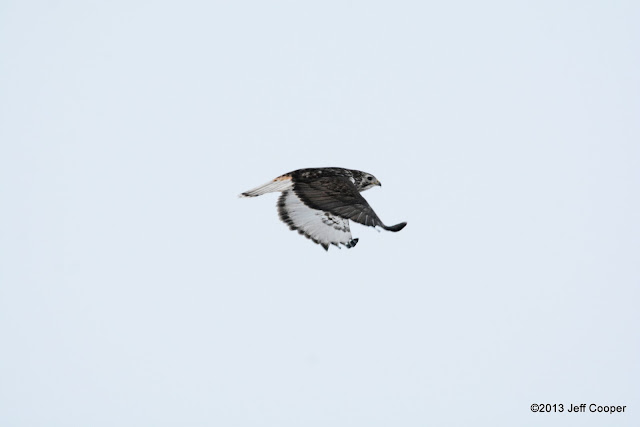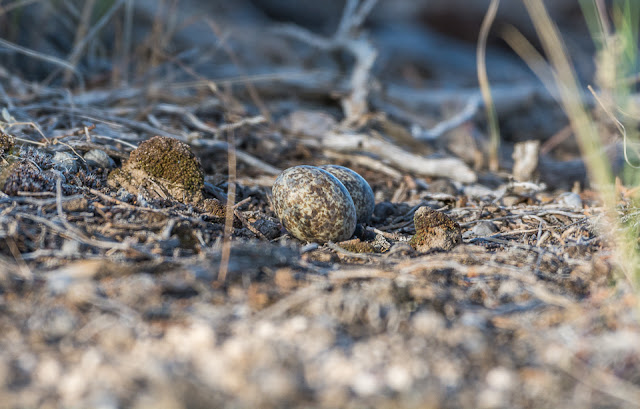I went for a short drive a couple of Saturdays ago to see if any northern raptors had made their way down to Utah County, Utah for the winter. I was pleased to locate two Harlan's Red-tailed Hawks during my short drive. One appeared to be a dark adult I have observed in the same location for several winters running. The second individual was a dark juvenile that allowed me to capture a few images, including the one below.
 |
| Juvenile Dark Harlan's Red-tailed Hawk Near Fairfield, Utah |
Here's the post...
I shared a post about Harlan's Hawks late last October (2013) as I was anticipating their arrival from their breeding grounds of Alaska and northwestern Canada. In lieu of observing these hawks on their distant breeding grounds I did the best thing I could do in terms of studying them in the field by searching for while they were wintering in the lower western states. In fact, my search for them was even smaller than the western states. It was essentially limited to Utah County, Utah. I located, photographed, and documented as many individual Harlan's Hawks as I could between November 2013 and April 2014. I tried to learn as much as I could about identifying this highly variable race before and during the winter months so I could discern them among the multitude of Red-tailed Hawks I encountered. I want to thank raptor expert, author, and photographer Jerry Liguori for educating me in my ongoing interest in and study of raptors. He is the one who turned me on to Harlan's Hawks in the first place when he let me know one of my photos of a Red-tailed Hawk several years ago was more specifically a Harlan's type or race of Red-tailed Hawk. He's conditioned and encouraged me to be more discerning with hawk observations. I'm also grateful to local birders who have increased their awareness of Harlan's Hawks. I see more being reported via eBird and local listservs.
After putting an informal focus on all the Red-tailed Hawks I observed in Utah County during the 2013/14 winter season I am certain that we have many more Harlan's-type Red-tailed Hawks visiting Utah during the winter months. I believe that many Utah birders are identifying a number of Harlan's Hawks as typical "Red-tailed Hawks" or simply "Buteo species" in their eBird reports.
Here's a summary of Harlan's Hawks I observed in Utah County during the 2013/14 wintering season:
- 13 individual Harlan's Hawks positively identified, some others were possible but not positively identified
- 11 adults (8 dark, 3 light)
- 2 juveniles (1 dark, 1 light)
Utah winters produce lots of raptors. Unfortunately, the overcast skies and poor lighting experienced during many winter days make it difficult to get quality images. Since this post is primarily about documenting the presence of a species I'm overriding my typical desire to share quality images and including a number of low-quality photos.
Harlan's Number One in Provo, Utah
Adult light-morph showing large amount of white around the eyes, light banding on the belly, mostly banded flight feathers, mostly white and gray tail with some rufous coloring. A local birder, Brenton Reyner, originally located and photographed this bird. I was in the area sometime later and relocated the bird.
Number Two in Lehi (Near Pioneer Crossing Ponds)
Dark adult showing heavy white streaking on chest. The upper side of the tail was mostly dark on this one. Some mottling was visible on the light under tail feathers.
Number Three in American Fork
Light Adult showing prominent white coloring on the upper side. The head showed heavy white streaking and white arc over eyes. Tail was mostly gray/white. I found an adult light-morph Harlan's Hawk in the same field two years earlier. This bird was present only the night I found it. The image was captured from a significant distance after sunset so it has been severely cropped and lightened. I think this hawk moved on because the field nearby had been cultivated. Cultivating disturbs the habitat preferred by the prey of these hawks, voles and other small mammals.
Number Four in Lehi
Dark Adult with heavy white streaking in the chest along with white streaking in the head. Very little banding in the flight feathers and dark mottling in the under side of the tail feathers. Upper side of tail is mostly dark and rusty with some white/gray. This hawk remained in the area for about a week straight. I saw it off the freeway every day on my way home from work.
Number Five in Lehi
Dark adult with rufous under-tail coverts. I haven't noticed that trait with Harlan's Hawks I'd observed previously. The tail shows a rufous base and tips with a mix of dark, gray, and white. Heavy white streaking in the chest. Mostly banded flight feathers.
Number Six in Lehi
This was a beautiful bird. I was delighted to find this one on New Year's Eve. It was the last bird seen in 2013. It was my first hawk on New Year's Day. It is an adult light-morph with more dark streaking on the underside than I've seen so far on light Harlan's Hawks. The head had contrasting white and dark markings. The tail was mostly white with rufous at the base and a thin dark band at the tips. I saw no banding in the wing or tail feathers. Some light rufous spotting on the under-tail coverts. Slight mottling on the underside of the tail near the tips.
Number Eight
Dark Juvenile south side of Pioneer Crossing and Mill Pond Area. No photos were obtained. This bird was present for only one observation as the sun was setting.
Number Nine
Dark Adult along Spring Creek in Lehi. Tail was a mix of white, gray, and slight rufous coloring.
Number Ten
Dark adult on SR68 north of Elberta. Mostly dark bird with nearly all dark tail. No photos obtained for this one.
Number Eleven
Juvenile Light Morph on SR 77
This bird was severely back lit so I had to lighten the image. The chest and belly of this bird appeared snow white from a distance in the field. The hawk flushed just as I pulled over to capture an image. It had streaking in the head feathers. The marking on the belly was thicker and more contrasting (blotchy rather than streaky) than expected for typical Western Red-tailed Hawks. Barring can be seen extending to the tips of the primary feathers. Barring to the tips on juveniles (not necessarily adults) is indicative of Harlan's. This trait does not apply to adult birds.
Number Twelve
Dark Adult on south side of SR 92. No photos captured.
Number Thirteen
Dark adult found in the same field with Number 5. Both hawks hunted in the same area for weeks. This one had more of a typical looking Red-tailed Hawk tail. It was mostly rufous with thin dark banding, but it also had mottling under the tail and some gray mixed in with the tail. This might be an intergrade of Harlan's and Western Red-tailed Hawk.


















































